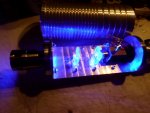- Joined
- Jul 10, 2015
- Messages
- 13,083
- Points
- 113
I have built several, it's not prohibitively difficult as long as you are patient, you just have to line everything up by aligning on a distant point, I use a board @ 15 feet and it works well, my point at infinity looks amazing and lighting paper/cardboard @ 50 feet is no problem and even without the beam expander the corrected beam looks much better, much more the way a laser beam should.......this unit is meant to be a 2 x 44 build, that's the reason there's so much empty space, but I was testing the mount for heat transfer so I didn't take a lot of build pics or post about it but here's a corrected 5W 7A75 I did a while back


p.s. The idea was to PBS combine 2 x 44 and I have a wave plate to rotate the 2nd beam then correct the combined beam with a 6X C-lens pair but I think I want to correct each beam 1st via. 6X c-lens pairs then PBS combine the corrected beams and it's all going to align perfectly with a beam expander mounted at the output. Do you think that would be the better way to go ( correcting each beam 1st ) it would reduce the energy density at the PBS as the beams would be expanded to their final size, if I tried to PBS combine straight out of my G2's the beams would still be pretty small/tight at the cube which could be a problem, I should test one but they were expensive and hard to get cubes that are able to take 2 x 44's so I think I want to correct each beam 1st, also I like to correct the beam as soon as possible as the fast axis divergence is so aggressive.


p.s. The idea was to PBS combine 2 x 44 and I have a wave plate to rotate the 2nd beam then correct the combined beam with a 6X C-lens pair but I think I want to correct each beam 1st via. 6X c-lens pairs then PBS combine the corrected beams and it's all going to align perfectly with a beam expander mounted at the output. Do you think that would be the better way to go ( correcting each beam 1st ) it would reduce the energy density at the PBS as the beams would be expanded to their final size, if I tried to PBS combine straight out of my G2's the beams would still be pretty small/tight at the cube which could be a problem, I should test one but they were expensive and hard to get cubes that are able to take 2 x 44's so I think I want to correct each beam 1st, also I like to correct the beam as soon as possible as the fast axis divergence is so aggressive.
Last edited:




